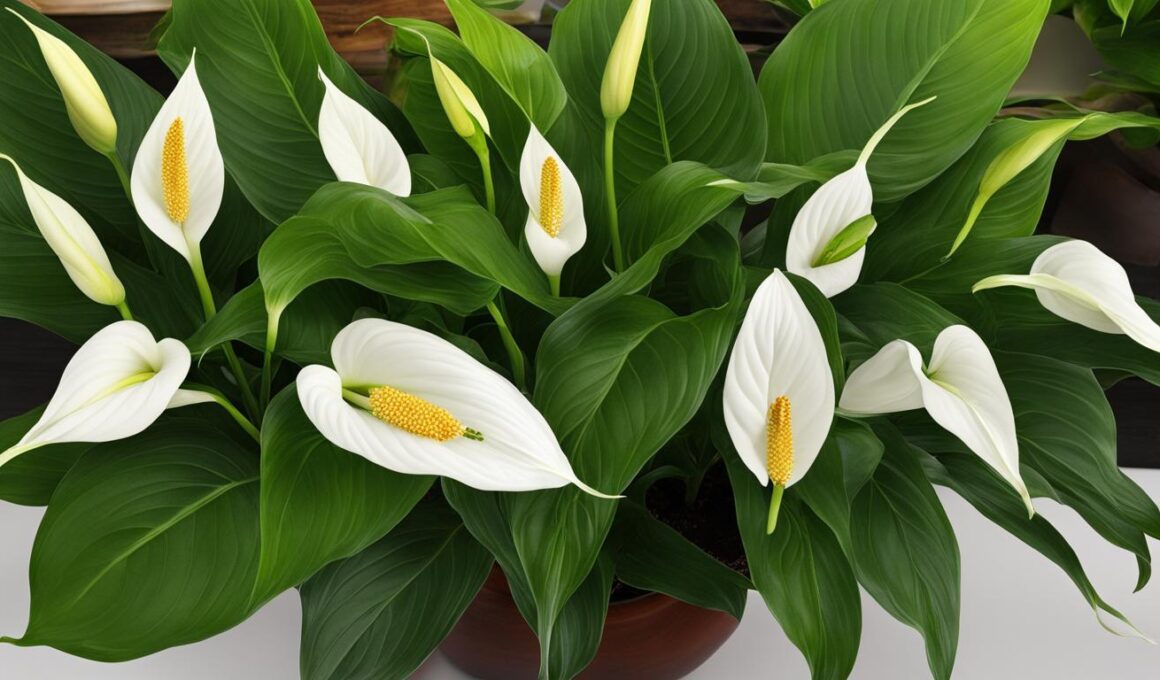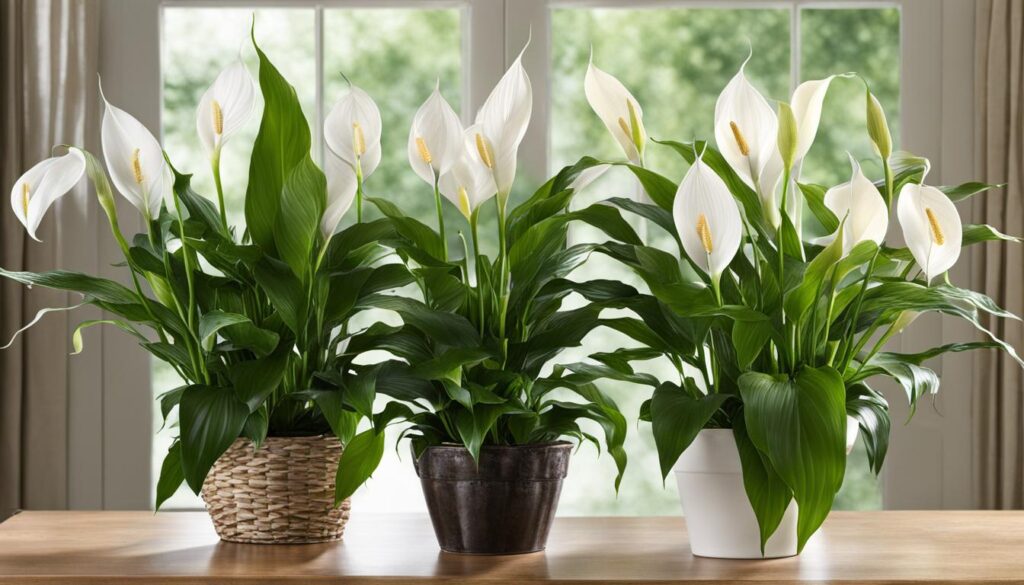Welcome to a fascinating exploration of the beautiful peace lily and its mesmerizing flower stages. If you’ve ever wondered about the growth phases, budding, and blooming process of this tropical plant, you’re in the right place. Let’s dive in and discover the enchanting journey of the peace lily.
The peace lily, scientifically known as Spathiphyllum, is cherished for its large, glossy, oval leaves and its ability to bloom multiple times a year. With proper care, you can enjoy months of stunning flowers that grace this vibrant plant. Understanding the flower stages of the peace lily is crucial to maintaining its health and ensuring its everlasting beauty.
First comes the stage of budding, where small, tightly closed flower buds begin to emerge from the green foliage. This is an exciting time, as the anticipation of vibrant blooms fills the air. As the buds gradually open, the peace lily enters the blooming stage, showcasing its stunning white flowers. The blossoms are delicate and elegant, radiating a sense of purity and tranquility.
After the peak of its bloom, the peace lily will naturally go to seed, developing small green fruits. As the seeds mature, the plant will start to wilt, indicating the end of its flowering cycle. While the wilting stage may seem melancholic, it is a natural part of the peace lily’s life cycle.
To ensure your peace lily thrives and continues to dazzle with its flowers, proper care is essential. In the next sections, we will explore different types of peace lilies, their symbolism, and expert tips for nurturing these remarkable plants. Let’s unravel the secrets of peace lily care together.
Types of Peace Lilies and Symbolism
When it comes to peace lilies, there is an abundance of variety within the Spathiphyllum genus. From miniature plants perfect for small spaces to massive specimens that make a statement, there is a peace lily to suit every preference. Some popular types of peace lilies include:
- Spathiphyllum ‘Power Petite’
- Spathiphyllum ‘Mauna Loa Supreme’
- Spathiphyllum ‘Sensation’
- Spathiphyllum ‘Mojo’
- Spathiphyllum ‘Golden Delicious’
- Spathiphyllum ‘Starlight’
Aside from their diverse appearances, peace lilies also carry deep symbolism. These plants are often associated with qualities such as sympathy, healing, hope, purity, and peace. It is no wonder that peace lilies have become a popular choice as a gift for those who have experienced loss, providing comfort and solace in times of grief.
Care Tips for Peace Lilies
If you’re looking to add some greenery to your indoor space, peace lilies are an excellent choice. These lovely plants, scientifically known as Spathiphyllum, are commonly grown as potted houseplants in the United States. To ensure their health and beauty, here are some essential care tips for your peace lilies:
1. Sunlight:
Indirect sunlight is key for peace lilies. They thrive in bright, filtered light, so place them near a window where they can receive ample but gentle sunlight.
2. Watering:
When it comes to watering peace lilies, it’s all about finding the right balance. Check the top inch of soil and water when it feels dry. Remember not to overwater, as peace lilies prefer moderately moist soil.
3. Indoor Environment:
Peace lilies prefer consistent temperate conditions. Keep them in a room with temperatures ranging between 65 and 80 degrees Fahrenheit. These plants also appreciate high humidity, so consider placing them in a bathroom or using a humidifier.
4. Potting and Soil:
Peace lilies like to be slightly root-bound, so choose a pot that allows for some growth but isn’t too spacious. Use a well-draining potting mix that retains moisture without becoming waterlogged.
5. Fertilizing:
To promote strong growth and blooming, feed your peace lilies with a balanced fertilizer during the summer months. Follow the instructions on the fertilizer package for the correct dosage and application method.
By following these care tips, you can ensure that your peace lilies stay healthy, vibrant, and a beautiful addition to your indoor space. Enjoy the calming presence and air-purifying benefits they bring!
Troubleshooting Common Issues and Propagation
Peace lilies are generally low-maintenance plants, but they can encounter some common issues that may affect their flowering and overall health. Understanding these problems and their solutions can help you ensure the thriving growth of your peace lily.
One of the most common issues with peace lilies is the lack of flowering. If your peace lily is not producing flowers, several factors could be at play. Firstly, it may be too young. Peace lilies typically start flowering when they reach maturity, which can take a couple of years. Additionally, insufficient light, improper watering, lack of fertilization, or temperature problems can also hinder the flower production. Ensuring your peace lily receives adequate indirect sunlight, maintaining consistent watering practices, feeding it with a balanced fertilizer during the growing season, and keeping it in a temperature range of 65-80 degrees Fahrenheit can encourage blooming.
If you notice your peace lily’s flowers are green instead of the expected white color, don’t panic. This can happen when the flowers are still developing. As the blooms mature, they will gradually turn white. However, if your peace lily has consistently green flowers or the foliage also appears green, it could indicate an excess of light or fertilizer. Adjusting the light exposure or reducing the frequency of fertilization can help restore the typical bloom color.
Some peace lily varieties naturally produce smaller flowers compared to others, so it’s essential to check if your plant falls into this category. However, if you observe a sudden change in the size of flowers or if multiple flowers are significantly smaller than usual, it might be a sign of an underlying care issue. Ensure your peace lily is receiving adequate light, water appropriately, and maintain proper humidity levels to promote healthy flower development.
Propagation is an excellent way to expand your peace lily collection or share it with others. The most common method of propagation for peace lilies is through division. To propagate your peace lily, carefully remove the plant from its pot and divide it into smaller clumps, making sure that each division has several stems and a healthy root system. Plant the divisions in fresh, well-draining potting mix and provide them with the same care as mature peace lilies. With proper attention and care, the new divisions will establish and grow into independent plants.
How Does Soil pH Affect the Growth Stages of Peace Lily Flowers?
The growth stages of Peace Lily flowers can be impacted by soil pH. Peace lilies thrive in slightly acidic soil, similar to roses. A pH level between 5.5 to 6.5 is ideal for their growth. If the soil becomes too alkaline or acidic, it can affect the plant’s ability to absorb nutrients, leading to stunted growth and yellowing of leaves. Maintaining the right pH level is crucial for healthy and vibrant Peace Lily blooms.










